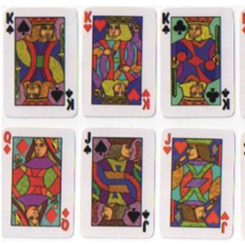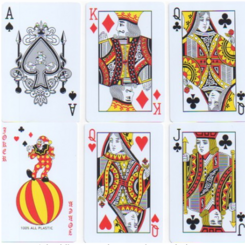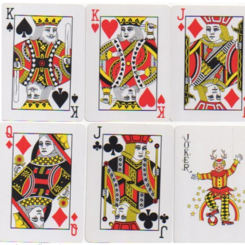Hakka
“Double Happiness” brand Hakka [客家] playing cards used by Hakka ethnic communities who have a separate identity from Cantonese,
“Double Happiness” brand Hakka [客家] playing cards made by Xiang Fa Company (used by Hakka ethnic communities who have a separate identity from the Cantonese people), 38 cards, 2000. The wrapper of the Hakka playing cards (right) shows the phrase: "中國江蘇製造” (Made in Jiangsu, China).
Chinese Characters for 1 to 9:
1 2 3 4 5 6 7 8 9
一 二 三 四 五 六 七 八 九
![“Double Happiness” brand Hakka [客家] playing cards used by Hakka ethnic communities “Double Happiness” brand Hakka [客家] playing cards used by Hakka ethnic communities](/images/countries/china/double-happiness-logo.jpg)
![“Double Happiness” brand Hakka [客家] playing cards used by Hakka ethnic communities “Double Happiness” brand Hakka [客家] playing cards used by Hakka ethnic communities](/images/countries/china/hakka-overview.jpg)
Above: general overview showing the cards arranged according to rank and suit. On the right you see the two extra cards in the deck.
Each of the cards has two symbols, one on the top, and another at the bottom. The one at the top displays the value of the card, the bottom one its suit. The suits of this deck, like mahjong, are based on ancient Chinese coinage. The lowest value, single coins, marked by the word 綫 , meaning "Thread" The word should by right be 錢 ( which is the Chinese for coin), the characters got mixed up some time in the past. The next highest value 100s of coins is marked, 索 = rope, or cable. This is a reference to the practice of stringing up coins in bundles of 100. Above that we find Guan, 貫, meaning a string of ten thousand coins. Highest of all is 拾 a word meaning 10, but in this context implies a bunch of 100,000 coins. Note that the Chinese word for 100,000 is 萬, the third suit in Mahjongg.
![“Double Happiness” brand Hakka [客家] playing cards used by Hakka ethnic communities “Double Happiness” brand Hakka [客家] playing cards used by Hakka ethnic communities](/images/countries/china/hakka-2.jpg)
Above: numbers are shown on the top row, the suit signs on the bottom. The number signs can be recognized as Chinese characters, albeit very stylized ones. Note that beneath the the circular symbol of the Aces is the phrase “ 中國江蘇製造” - Made in Jiangsu, China, which also occurs on the wrapper on the deck. The suit signs are simply the cursive versions of the respective Chinese characters. The only exception is the sign for the suit of 貫 which is slightly stylized. However, there are exceptions. The Ace in the suit of 拾 is marked 百子, " A hundred children", instead of using the expected sign. The ace in the suit of coins, is more mysterious. The first character is definitely毛, Mao , meaning hair. It can also be a surname ( think Mao Zedong ). The second character is ambiguous. One source suggests 公, meaning duke. If this is true, then the inscription would read "Duke Mao".
Right: the two extra cards of the deck. The bottom character in card A is definitely 綫 ("Thread"), and the bottom character in card B is 花 (flower). However, the top characters in both cards have defied all attempts at interpretation.
![“Double Happiness” brand Hakka [客家] playing cards used by Hakka ethnic communities “Double Happiness” brand Hakka [客家] playing cards used by Hakka ethnic communities](/images/countries/china/hakka-4.jpg)
![“Double Happiness” brand Hakka [客家] playing cards used by Hakka ethnic communities “Double Happiness” brand Hakka [客家] playing cards used by Hakka ethnic communities](/images/countries/china/hakka-3.jpg)
Left: decipherinng some of the inscriptions on the deck. In the first row, we see the maker's name is written across the 6s in the deck, 祥發公司-- Xiang fa company. In the second row, you see the name of the company, 祥發 written on some of the cards. These two characters when taken alone, mean "happiness" and "To flourish", respectively. In the third row, we see the words 大字纸牌 written across the 2s in the deck. This means "Big character playing cards". Note that, in order for any of the inscriptions to make sense, the suits cannot be arranged in the order described above. Why this is so, I do not know.
Apart from being called 客家牌 (Hakka cards in Chinese) these cards are sometimes called 六虎牌 "Six tiger cards", as one of the games that uses these cards is called "Six tigers".
六虎牌 Six tiger cards, 鴻獅廠 Hong Shi Factory
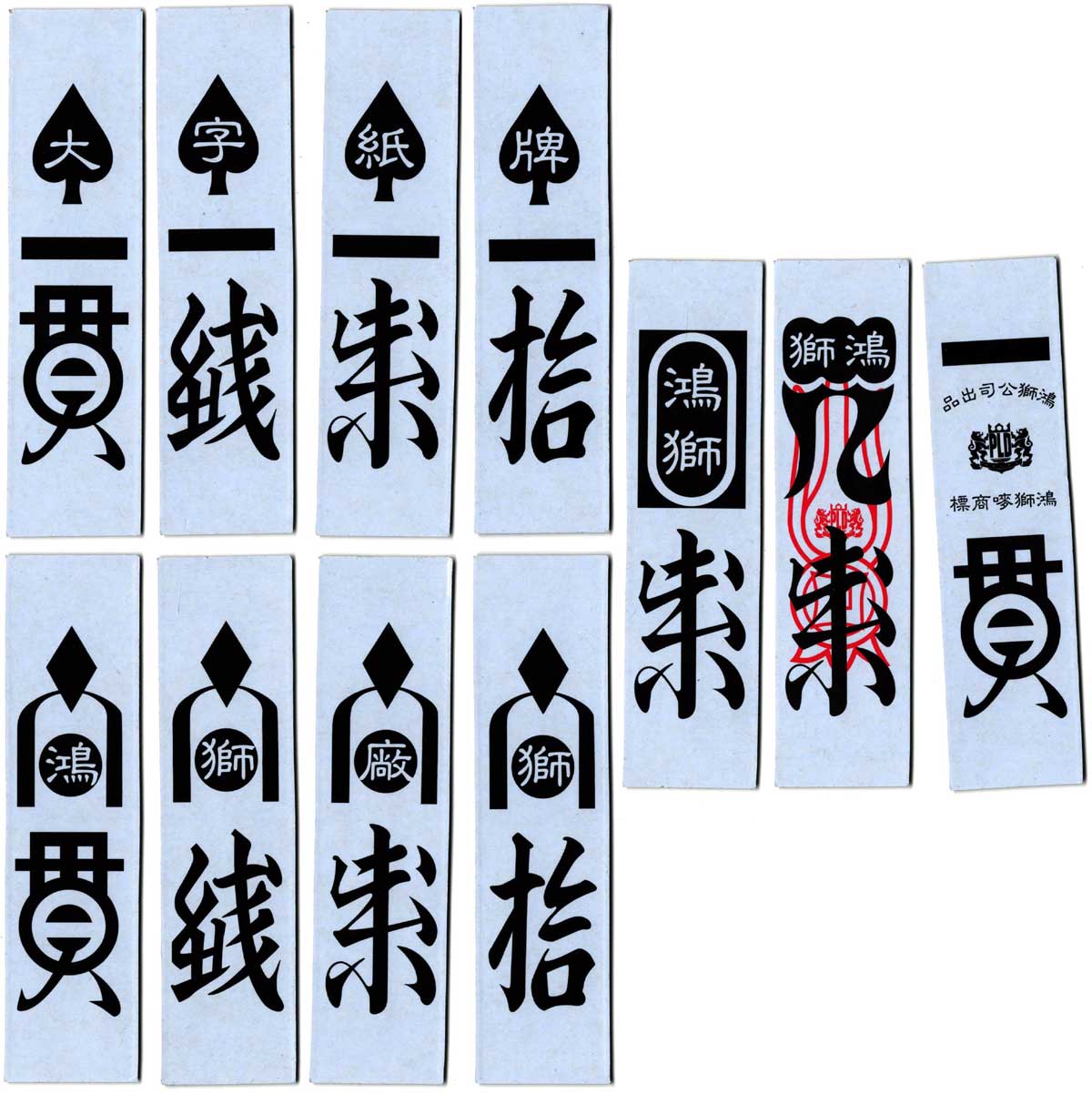
Above: 六虎牌 Six Tiger cards made by Hong Shi 鴻獅, Guangdong province. The inscriptions are the same as before: 大字紙牌 on the 2s of each suit (top row). Rather pleasingly, the order you have to arrange the suits in to reead the inscription is the same in both the Hong Shi and Double Happiness decks. The maker’s name is written on the 8s and 9s of each suit. The ace bears the maker’s stamp (row offset to the right: cards shown are, in order, 8 and 9 of ropes and the ace of Guan). The maker’s name is also added on the 6s of each suit (bottom row). The Three of the cards read 鴻獅廠 "Hong Shi Factory". The fourth card reads 獅, "Lion" again. As for the cards themselves, they are made from a fairly thick cardstock (approximately double the thickness of normal cardstock) and have a pleasing glossy finish. Their backs are plain black in colour. The package is shown below.
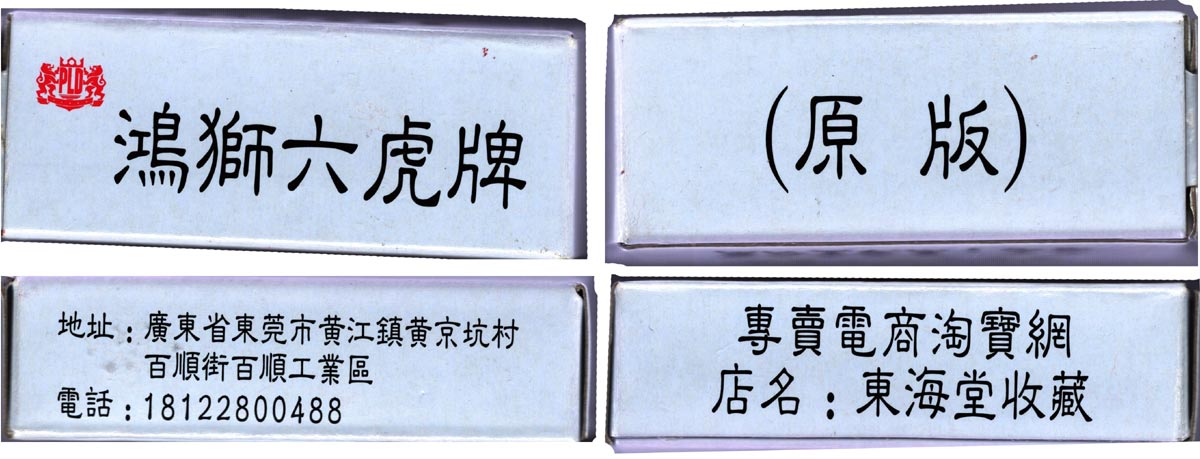
Above: Top left: 鴻獅六虎牌 Hong Shi Six Tiger cards. 2nd image: The company's address and contact number:
Guangdong province, Dongguan city, Huangjiang Town, Huang Jin Keng village, Bai Shun street, Bai shun industrial district Phone Number : 18122800488.
3rd image: The words 原版 "Original edition". 4th image: "Exclusive online retailer is Taobao. Shop name: Donghaitang Shouchang (Collection of Eastern-sea hall).
The Maker's online shop can be seen below: The "Taobao" refers to a Chinese web site that has been compared to Amazon.com and Ebay.
It links consumers to retailers, who between them sell almost every product imaginable, from tofu to dining tables.
The link to the relevant shop is: https://shop68164124.taobao.com►
The makers sell two types of six tiger cards; an "Original" edition, and a slightly wider "Luxury" edition. The cards shown above are from the Original edition.
Images and notes courtesy Anthony Lee.

Leave a Reply
Your Name
Just nowRelated Articles

Chinese Money-Suited Playing Cards from the British Museum
This deck of Chinese playing cards, donated to the British Museum in 1896, is believed to have been ...
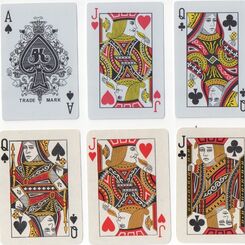
57: China 3
A third and final look at some Chinese cards.
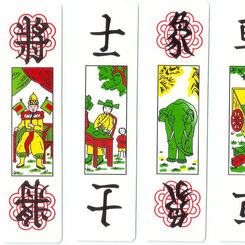
Tam Cúc 三菊
Tam Cúc playing cards from Vietnam (Việt Nam), based on Chinese chess, 2016
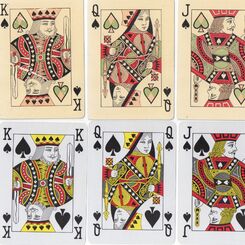
54: China 1
Although many people would not consider Chinese cards worth collecting, the huge variety of court de...

Terracotta Army
Each card has a different photo of elements of the terracotta army whose purpose was to protect the ...

Terracotta Warriors of Emperor Qin
“Terracotta Warriors of Emperor Qin” collectible playing cards, made in China, c.2010.
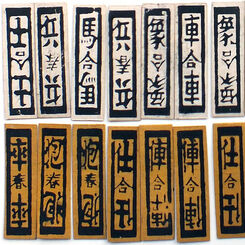
Four Colour Cards / 四色牌 / Si Sek Pai
Four Colour Cards made in Belgium for Far Eastern markets

Ceki Cards
Indonesian Ceki cards
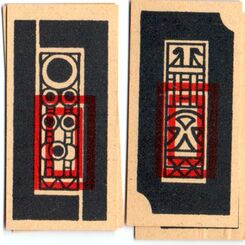
Chi Chi Pai
Chinese “Chi Chi Pai” Playing Cards by Mesmaekers Frères for Far East market.
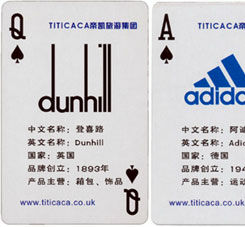
Titicaca ® Playing Cards
Each card in this novelty deck, subtitled “Funny Card”, carries information about a prestigious or p...

Li River Souvenir
Li River Souvenir Playing Cards from China.
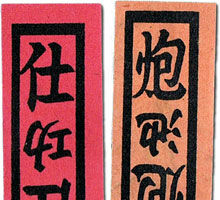
Hokkien Four Colour Cards
The characters on the cards are written one way for red and yellow, and another for green and white....
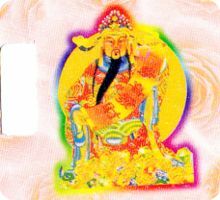
Chinese Fortune Telling Cards
Fortune Telling Cards - wondrous scientific divination poker cards.

Mahjongg
Mahjongg is usually played with tiles, which are Chinese playing cards made in solid form...
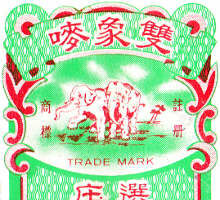
Playing Cards from Malaysia
Playing Cards from Malaysia.

Double Elephant & Double Dragon
Double Elephant brand Four Colour cards

Regional Cards: China and Hong Kong
Explore the history, patterns and designs of traditional Chinese playing cards, featuring unique reg...
Most Popular
Our top articles from the past 60 days


 Your comment here. Your comment here. Your comment here. Your comment here. Your comment here. Your comment here. Your comment here. Your comment here. Your comment here. Your comment here. Your comment here. Your comment here. Your comment here. Your comment here. Your comment here. Your comment here. Your comment here. Your comment here. Your comment here. Your comment here. Your comment here. Your comment here. Your comment here. Your comment here. Your comment here. Your comment here. Your comment here. Your comment here. Your comment here. Your comment here. Your comment here. Your comment here.
Your comment here. Your comment here. Your comment here. Your comment here. Your comment here. Your comment here. Your comment here. Your comment here. Your comment here. Your comment here. Your comment here. Your comment here. Your comment here. Your comment here. Your comment here. Your comment here. Your comment here. Your comment here. Your comment here. Your comment here. Your comment here. Your comment here. Your comment here. Your comment here. Your comment here. Your comment here. Your comment here. Your comment here. Your comment here. Your comment here. Your comment here. Your comment here.
